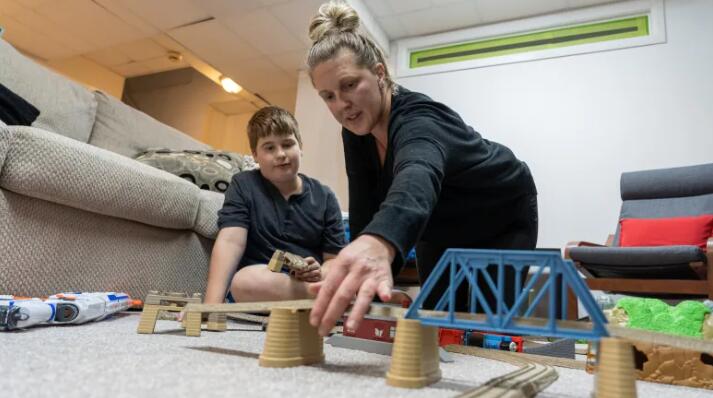Pandemic further delays autism support for kids who’ve spent years on wait lists Social Sharing

Province says system was ‘broken’ and it will add 8,000 kids to core services by end of fall
Sonja Elliott is in a panic for her son Travis.
The sixth grader was diagnosed with autism four years ago and has been on a wait list for core clinical services from the Ontario government since.
In the meantime, she’s paying about $2,100 out of pocket each month for support, but estimates it’s still only half what Travis needs. The problem is, therapy centres aren’t taking on new kids.
“Every therapist I call … is a minimum six month wait time. A lot of them are up to a year or even longer.”
Some centres in Ottawa have closed their wait list altogether, according to Elliott.
“It feels horrible because I’m his mom. That’s my job. I’m supposed to look out for him.”
- Progress in autism program rollout goes dark as Ontario government withholds new updates
- Ontario children and teens with autism faced long waits, education loss in 1st year of pandemic, report finds
Travis just turned 11.
“I’m petrified that he’s going to age out before he even received service,” Elliott said, referring to her son reaching an age where he will no longer be eligible for supports.
It’s a stress for families that has become more severe through the COVID-19 pandemic. Parents and advocates say the wait for supports has grown and staffing has shrunk, all while waiting on the province to whittle down its own wait list for funding, which they say is keeping kids from care.
A search of local therapy and support centres shows a similar pattern for ADHD programs.
Families paying for support with 2nd mortgages
The wait list at Thinking in Pictures Educational Services (TIPES) in Ottawa is generally around 30 kids long and typically takes about three months from sign up to receiving support, said executive director Jennifer Wyatt.
She described the list as something she struggles with daily.
“It’s really unfair. They should have access to treatment,” Wyatt said of the children who are waiting.

She’s seen parents take out a second mortgage on their home to pay for the support their child needs. Others have tapped into an inheritance or asked their extended family for help.
Wyatt said she’s also watched support costs climb during the COVID-19 pandemic, hitting $178 an hour at some centres.
“How is the average person is supposed to afford that?” she asked.
For many there’s no choice.
Province promised 8,000 kids by end of fall
More than 56,000 children have signed up with the Ontario Autism Program (OAP), though the majority have not received core services funding, leaving families to wait or try to cover expensive support on their own.
Most have been given some one-time payments and thousands of others have accessed areas of the program.
Merrilee Fullerton, minister of children, community and social services, pledged to get 8,000 kids into core services by the end of the fall. But as of August, that number was only around 888 and the government has since refused to share its progress, The Canadian Press reported.
In a statement to CBC News, Fullerton’s spokesperson Patrick Bissett said the OAP was “broken” when the Progressive Conservatives took over and they’ve since doubled its funding to $600 million.
The rollout of the program is “progressing well” with 15,269 invitations sent out, he added.
Bissett did not respond to requests asking for an updated enrolment number.
Pandemic compounded struggle
Kerry Monaghan, a board member for the Ontario Autism Coalition, said the invitations the province mentioned are simply emails that don’t actually connect children with services. They simply direct families to create an online profile so they can continue waiting.
The lack of action is a constant source of stress, said Monaghan, who also has two children with autism.
“When you’re waiting that long, families lose hope. They become more desperate,” she said, comparing the waits to “emotional waterboarding.”
While her nine-year-old son is with the OAP, her daughter has been on a wait list since she was diagnosed around the age of two. She’s now seven.
The family is spending tens of thousands each year to support her, but said they are also running into walls when it comes to availability.
Calling around to arrange reassessments revealed nine-month waits, Monaghan said.
Her kids also stopped attending speech and occupational therapy during pandemic shutdowns, but her attempts to sign them back up have been met with closed wait lists.
Pandemic shutdowns and a change in approach by the government, which moved from consistent funding to lump sum payments, left centres struggling to hold onto staff and keep their doors open, according to Monaghan.
That means even those who manage to secure government support or find a way to pay for it themselves are met with yet another wait list — this time in the private sector. Meanwhile, their funds from the province could disappear.
“If they don’t use it they lose it,” said Monaghan. “How demoralizing is that?”
Elliott said not being in school during pandemic closures meant a loss of social and academic learning for Travis.

She watched her child’s hard-earned coping skills, picked up in therapy and class, melt away and she worries how he’ll get them back without support.
In the meantime, money concerns continue to mount as the wait drags on and she has no idea when it will end.
Related News
Trump signs executive order to speed up deepsea mining permits
U.S. President Donald Trump on Thursday signed an executive order aimed at boosting the deepseaRead more
See the Ukraine war ceasefire proposals put forth by the Trump administration
Reuters has seen the text of a set of proposals to end Russia’s war inRead more
